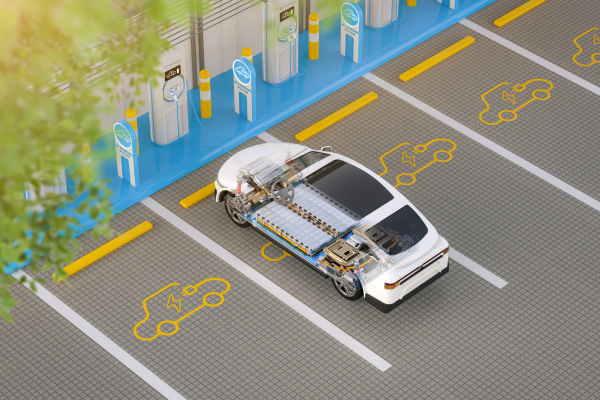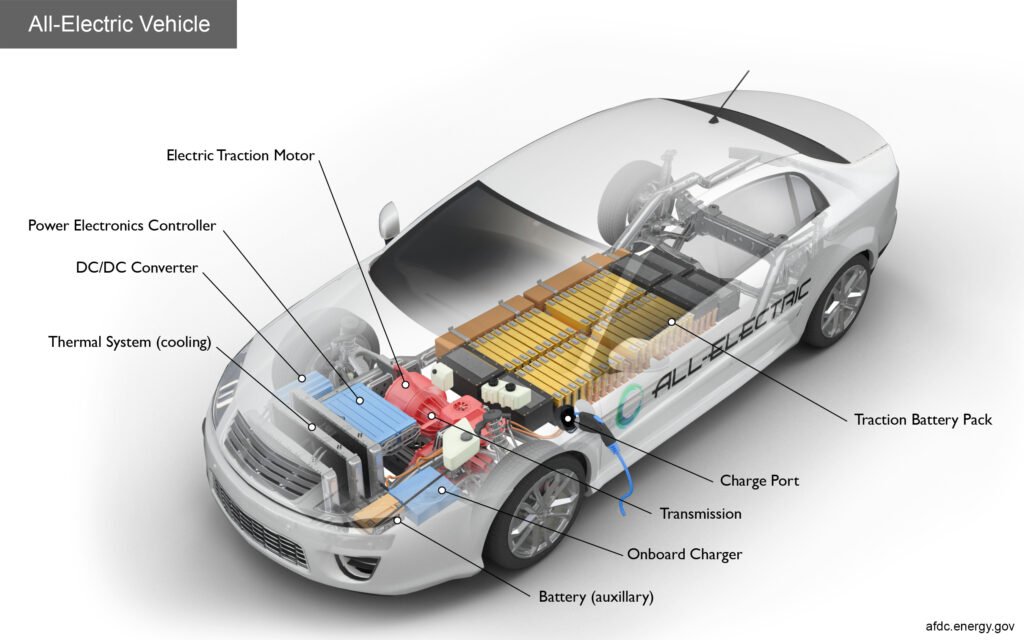Table of Contents
- Introduction
- Key Components of Electric Vehicles
- Conclusion
- Frequently Asked Questions
Introduction
Key Components of Electric Vehicles
1. Battery System:

- The battery pack is the heart of an electric vehicle, providing the necessary power for propulsion.
- EV owners should adhere to manufacturer guidelines regarding charging practices, avoiding frequent deep discharges, and overcharging.
- Regularly monitoring battery health through onboard diagnostics or specialized tools can help detect any abnormalities early on.
- Optimal charging practices, such as avoiding extreme temperatures and utilizing smart charging solutions, can prolong battery life and maintain efficiency.
2. Electric Motor:

- The electric motor converts electrical energy from the battery into mechanical energy to propel the vehicle.
- While electric motors are known for their durability, periodic inspection for wear and tear is advisable.
- EV owners should ensure the motor remains free from debris and contaminants, as these can affect performance.
- Following recommended maintenance schedules, including lubrication of moving parts if applicable, can prevent premature motor failure.
3. Charging Infrastructure:

- EV owners need to have access to reliable charging infrastructure, whether it’s at home, work, or public charging stations.
- Keeping charging connectors clean and free from corrosion ensures efficient charging and reduces the risk of damage to both the vehicle and the charging station.
- Familiarizing oneself with different charging standards and connectors can facilitate smooth charging experiences, especially during travel.
4. Vehicle Cooling System:
- Electric vehicles rely on cooling systems to regulate temperatures, especially during high-demand situations such as fast charging or prolonged driving.
- Regular inspection of coolant levels and ensuring proper airflow to radiators or heat exchangers is essential for preventing overheating.
- Addressing any cooling system issues promptly can prevent damage to critical components and ensure optimal vehicle performance.
5. Braking System:
- Electric vehicles often utilize regenerative braking systems, which convert kinetic energy into electrical energy to recharge the battery.
- While regenerative braking reduces wear on traditional brake components, periodic inspection of brake pads and rotors is still necessary.
- EV owners should be mindful of driving habits that optimize regenerative braking, such as anticipating stops and coasting whenever possible.
6. Tire Maintenance:
- Proper tire maintenance is essential for both safety and efficiency in electric vehicles.
- Regularly checking tire pressure and tread wear not only ensures optimal performance but also maximizes range.
- Rotating tires at recommended intervals promotes even wear and extends tire life, reducing the frequency of replacements.
7. Software Updates and Connectivity:
- Electric vehicles often rely on sophisticated software for various functions, including battery management, regenerative braking, and infotainment systems.
- Staying updated with software releases from the manufacturer helps address bugs, enhance performance, and unlock new features.
- Maintaining connectivity, whether through over-the-air updates or periodic visits to service centres, ensures the vehicle remains secure and up to date.
8. Safety Features:

- Electric vehicles come equipped with advanced safety features such as traction control, stability control, and collision avoidance systems.
- Familiarizing oneself with these features and understanding how they operate can help prevent accidents and mitigate risks on the road.
- Regular calibration and testing of safety systems, as recommended by the manufacturer, ensure they function as intended in critical situations.
9. Environmental Impact:
- EV owners have a responsibility to minimize the environmental impact of their vehicles beyond just driving emissions-free.
- Proper disposal of batteries at the end of their lifecycle is crucial to prevent environmental pollution.
- Exploring options for battery recycling or reuse programs can significantly reduce the ecological footprint of electric vehicles.
10. Driving Habits:
- EV owners can optimize their vehicle’s efficiency and range by adopting eco-friendly driving habits.
- Maintaining steady speeds, avoiding rapid acceleration and deceleration, and maximizing the use of regenerative braking all contribute to better energy efficiency.
- Planning routes to minimize unnecessary driving and utilizing features like cruise control can further enhance efficiency.
11. Education and Advocacy:
- EV owners play a vital role in advocating for sustainable transportation and dispelling myths or misconceptions surrounding electric vehicles.
- Sharing personal experiences, participating in community events, and engaging with policymakers can help promote the adoption of electric vehicles on a larger scale.
- Providing support and guidance to those considering EV ownership, including information on incentives, charging infrastructure, and available models, can accelerate the transition to cleaner transportation.
12. Collaboration with Service Providers:
- Establishing a collaborative relationship with service providers, such as electric utilities and charging network operators, can streamline the ownership experience.
- Providing feedback on charging infrastructure availability, reliability, and user experience can contribute to the improvement of charging networks.
- Collaborating with local authorities and businesses to expand charging infrastructure and promote EV-friendly policies benefits both EV owners and the broader community.
13. Continuous Learning and Improvement:
- As electric vehicle technology evolves rapidly, EV owners should stay informed about advancements, updates, and best practices.
- Engaging in online forums, attending workshops, and seeking advice from experienced EV enthusiasts can provide valuable insights and support.
- Remaining open to feedback and continuously evaluating one’s own driving and maintenance practices fosters a culture of continuous improvement and sustainability.
14. Infrastructure Development:

- EV owners can advocate for and support the expansion of charging infrastructure to make electric vehicle ownership more accessible and convenient for all.
- Collaborating with local authorities, businesses, and advocacy groups to identify strategic locations for charging stations in residential areas, workplaces, and public spaces.
- Participating in initiatives to install charging stations in underserved communities or areas lacking sufficient infrastructure promotes equity and inclusivity in the transition to electric transportation.
15. Community Engagement:
- Engaging with local EV clubs, online forums, and social media groups fosters a sense of community among electric vehicle enthusiasts.
- Organizing or participating in group events such as road trips, meetups, or educational workshops provides opportunities for networking, knowledge sharing, and camaraderie.
- Volunteering time and resources to support community initiatives, such as EV awareness campaigns or EV ride-and-drive events, helps raise awareness and promote the benefits of electric transportation.
16. Policy Advocacy:
- EV owners can actively engage with policymakers at the local, regional, and national levels to advocate for supportive policies and incentives for electric vehicles.
- Providing input on legislation related to electric vehicle incentives, charging infrastructure funding, and emissions regulations helps shape policies that accelerate the transition to sustainable transportation.
- Collaborating with environmental organizations, industry associations, and other stakeholders to lobby for policies that promote electric vehicle adoption and combat climate change.
17. Lifestyle Integration:
- Integrating electric vehicle ownership into everyday lifestyle choices can further enhance sustainability efforts.
- Exploring renewable energy options such as solar panels for home charging can reduce reliance on the grid and lower overall carbon emissions.
- Incorporating EV charging into daily routines, such as charging overnight or during off-peak hours, optimizes energy use and reduces electricity costs.
18. Educational Outreach:
- EV owners can serve as ambassadors for electric transportation by sharing their experiences and knowledge with friends, family, and colleagues.
- Hosting informational sessions, participating in community outreach events, or offering test drives to interested individuals helps demystify electric vehicle technology and dispel misconceptions.
- Providing guidance on available incentives, tax credits, and cost-saving benefits of electric vehicle ownership empowers others to make informed decisions about transitioning to electric transportation.
Conclusion
In conclusion, electric vehicle ownership encompasses a broad spectrum of responsibilities that extend beyond individual vehicle maintenance and operation. By actively engaging with their communities, advocating for supportive policies, and promoting sustainable lifestyle choices, EV owners can amplify the positive impact of electric transportation and drive meaningful change towards a cleaner, greener future. Embracing these responsibilities not only enhances the ownership experience but also contributes to building a more sustainable and equitable transportation ecosystem for generations to come.
Electric vehicles represent a paradigm shift in the automotive industry, offering environmentally friendly transportation without compromising performance or convenience. However, ensuring the longevity and reliability of electric vehicles require proactive care and maintenance from owners. By understanding and attending to the major components outlined above, EV users can maximize the benefits of their vehicles while contributing to a sustainable future.
In essence, owning an electric vehicle goes beyond simply driving from point A to point B. It entails a multifaceted commitment to environmental stewardship, responsible driving behaviour, community engagement, and personal growth. By embracing these responsibilities and actively participating in the electric vehicle ecosystem, owners not only contribute to a cleaner and greener future but also enhance their own ownership experience. As electric vehicles continue to gain traction worldwide, the collective efforts of EV owners will play a pivotal role in shaping the future of transportation for generations to come.
Frequently Asked Questions:
Electric vehicles consist of several major components, including the battery system, electric motor, charging infrastructure, cooling system, and braking system. Each of these components plays a crucial role in the performance, efficiency, and longevity of the vehicle.
To ensure the optimal performance and longevity of the battery system, EV owners should adhere to manufacturer guidelines for charging practices. This includes avoiding frequent deep discharges and overcharging, as well as monitoring battery health regularly. Additionally, practicing optimal charging habits, such as avoiding extreme temperatures and utilizing smart charging solutions, can help prolong battery life.
While electric motors are known for their durability, periodic inspection for wear and tear is advisable. EV owners should ensure the motor remains free from debris and contaminants, as these can affect performance. Following recommended maintenance schedules, including lubrication of moving parts if applicable, can prevent premature motor failure.
Electric vehicles often utilize regenerative braking systems, which convert kinetic energy into electrical energy to recharge the battery. To optimize efficiency, EV owners should adopt eco-friendly driving habits that maximize the use of regenerative braking, such as anticipating stops and coasting whenever possible. Additionally, regular inspection of brake pads and rotors is still necessary, despite reduced wear in comparison to traditional braking systems.
Charging infrastructure is essential for electric vehicle ownership, providing access to reliable charging solutions at home, work, and public locations. To ensure efficient charging experiences, EV owners should keep charging connectors clean and free from corrosion, familiarize themselves with different charging standards and connectors, and plan routes to optimize charging stops during travel. Additionally, providing feedback on charging infrastructure availability and user experience can contribute to the improvement of charging networks.

